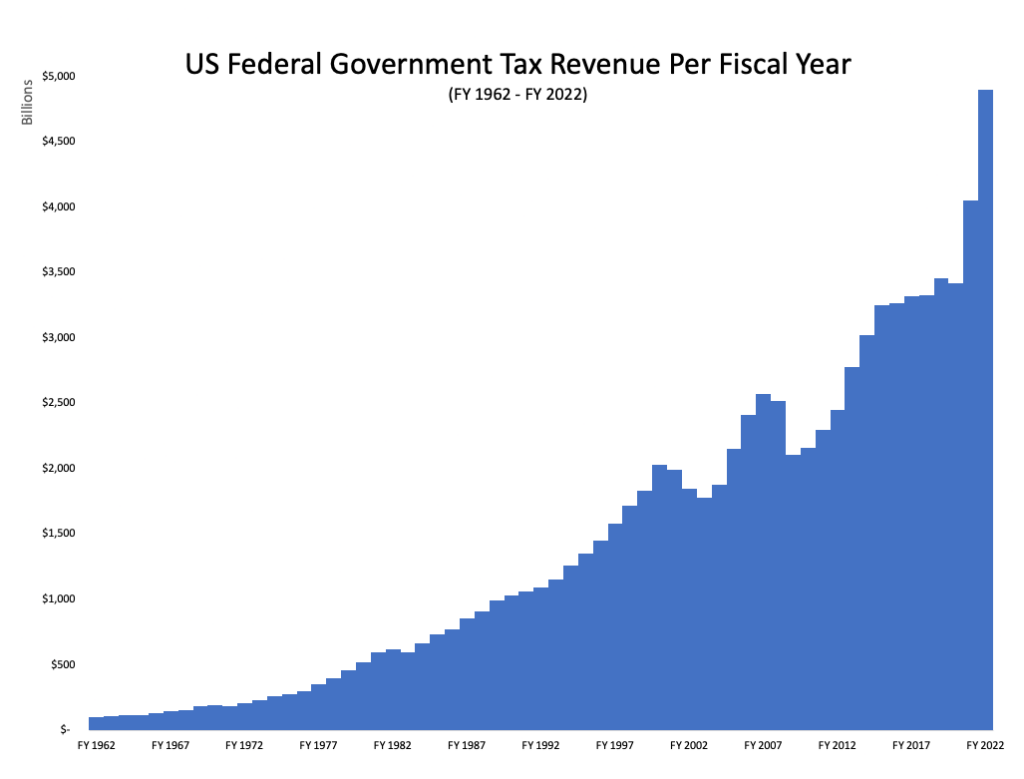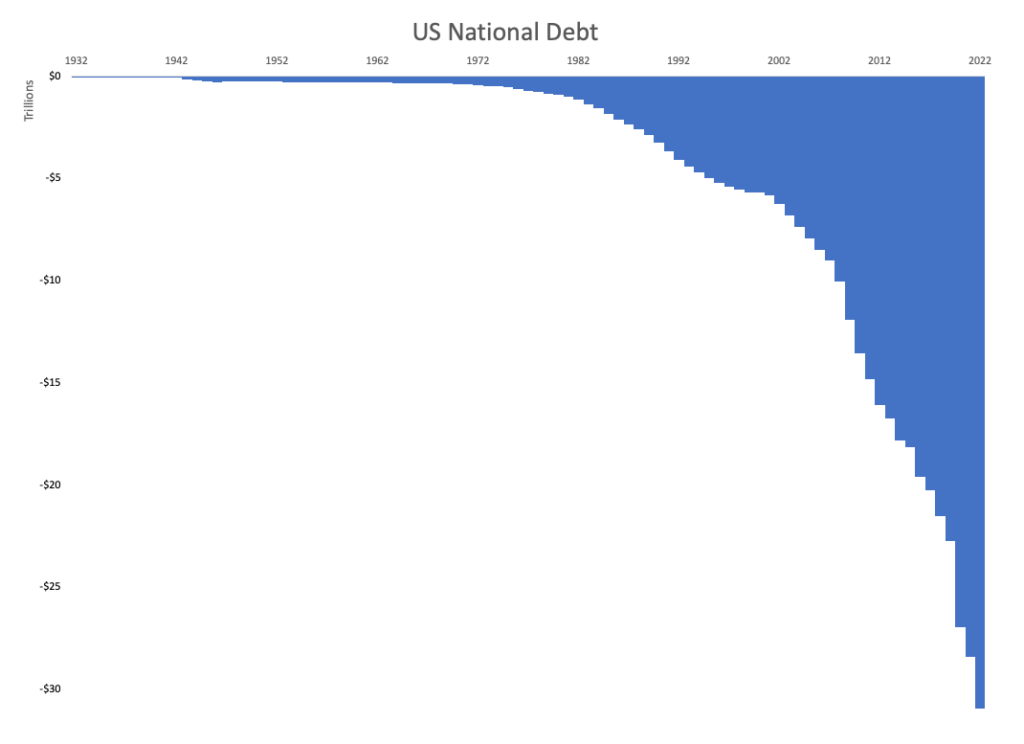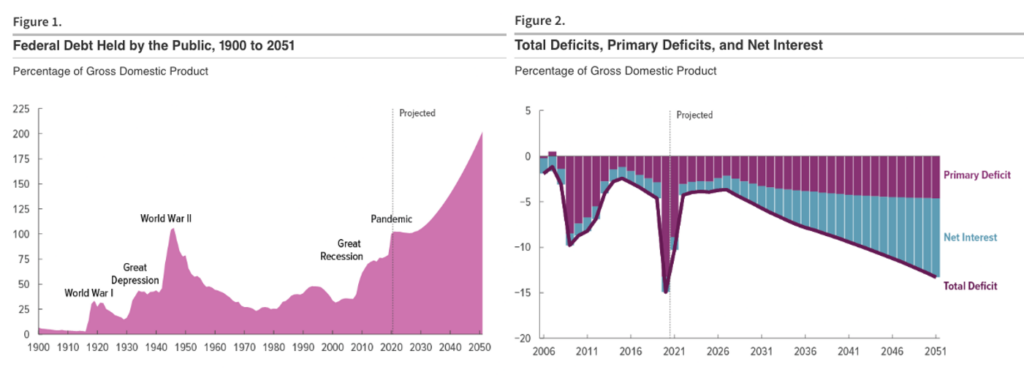By Brett Munster
The US Debt Spiral
Last newsletter we covered why the banking crisis is shifting the narrative of bitcoin within the US from a speculative asset to an asset that belongs in every portfolio because it provides protection against future uncertainty. There is another economic trend that is further reinforcing bitcoin’s sound money narrative and that is the US Debt Spiral.
To fully understand the debt spiral problem, we need to do some basic math. In 2022, the federal government collected $4.9 trillion of revenue, the primary source of which was individual income taxes. If that sounds like a lot, it is. In fact, the US government’s annual revenue has been steadily increasing for the past 50 years with 2022 the largest year ever.

Source: https://www.thebalancemoney.com/current-u-s-federal-government-tax-revenue-3305762
However, that’s only one half of the equation. We also must look at the federal government’s expenses which are broken down into 3 main categories. The first is “Mandatory Spending.” Mandatory spending, as the name implies, consists of expenses the government is required to spend as mandated by existing laws. This type of spending includes Social Security, Medicare, Medicaid and more. In 2022, Mandatory Spending came in at $4.1 trillion. For those of you keeping score at home, that leaves only $800 billion remaining in the government’s annual budget.
The second category is “Discretionary Spending.” Discretionary spending is money formally approved by Congress and the President during the appropriations process each year. Within this category, Defense spending constitutes by far the largest portion. 2022 saw the largest Defense budget in US history at $751 billion, roughly 44% of the entire Discretionary category.
Defense spending is only a portion of the Discretionary category which also includes infrastructure, transportation, education, housing, social service programs, science initiatives, environmental organizations, and more. For these programs, you can add in another $910 billion in spending by the US government in FY 2022. As you undoubtedly realized by now, the government spent more money than it took in last year. And we haven’t even gotten to the third category of expenses yet.
2022 wasn’t the first year the government ran a deficit. To pay for that deficit each year, the federal government borrows money which it has to pay back with interest. Over the years the US government has borrowed a lot of money (which is an understatement akin to calling the Grand Canyon a hole in the ground). The US government’s debt currently stands at over $31 trillion.

Source: https://fiscaldata.treasury.gov/datasets/historical-debt-outstanding/historical-debt-outstanding
This brings us to our third expense category, the interest payments the government owes on money it has previously borrowed, otherwise known as “Net Interest.” In 2022, the annual interest payment alone was nearly half a trillion dollars. That’s more than it will spend on elementary and secondary education, disaster relief, agriculture, science and space programs, foreign aid, natural resources, and environmental protection combined.
All in all, the US government spent $6.3 trillion in FY 2022 meaning it operated at a $1.4 trillion loss.

Source: https://www.cbo.gov/publication/58888
And that’s not even the bad news. As we continue to operate at a loss every year, the debt we take on as a nation grows. This means that the interest expense grows too. How do we cover that growing interest expense? We borrow more. Yup, borrow money to pay the interest on the debt we previously borrowed. This is known as a Debt Spiral. Currently, interest payments on the national debt have become one of the fastest growing segments of federal spending. In Q1 2023, the US federal government was spending $10.3 billion per day just on interest expense.

Source: https://fred.stlouisfed.org/series/A091RC1Q027SBEA#
And it’s about to get worse. A lot of that debt was accumulated in a low interest rate environment starting in 2008. But as current debt matures it gets replaced with debt at higher interest rates thanks to recent actions by the Fed. We have already started to see the impact of higher rates take effect as the average interest rate on federal debt rose from 1.6% in 2021 to 2.1% in 2022. That average rate is only going to further increase because roughly 30% of the debt is set to be refinanced in the next 12 months at today’s higher rates. And to make matters even worse, the Fed announced last week that it’s likely to raise interest rates even higher later this summer.
So, the US government is continuing to borrow more (current deficit for FY 2023 is already almost $1 trillion and we are only just past half way through the fiscal year) and at higher interest rates. Fun thought experiment for you. Should the average federal interest rate on federal debt rise just 1 percent from last year, that increases the US Government’s annual interest rate payment to nearly $1 trillion, more than double what it was in 2022. And that is before the US takes on a single penny of new debt which we already know it is guaranteed to do.
The higher interest rates climb and the more debt we take on, the larger the interest payment on the debt becomes. The larger the interest payment, the larger the deficit gets. The larger the deficit gets, the more debt that must be issued. More debt issued means larger interest payments on that debt. It took over 200 years for US Federal Debt to reach $2 trillion. Now it takes just over 1 year for the government to add an additional $2 trillion of debt. Bottom line, the interest payment will continue to grow substantially in the coming years.
But don’t take my word for it. The Congressional Budget Office’s own projections (which is probably as optimistic of a forecast as it gets) indicate that by 2042, the US government will be spending more on net interest than Social Security, Medicare, Medicaid or Defense spending, making it the single largest line-item expense on the government’s budget. In all reality, it probably will happen well before 2042.

Source: https://www.cbo.gov/publication/57038#_idTextAnchor007
In the not-too-distant future, the combination of Mandatory Spending and Interest Payments alone will become greater than the tax revenue of the US. In other words, just taking into account the expenses we can’t avoid, the US government’s expenses will exceed its revenue. That’s BEFORE we add in Defense spending, the rest of the discretionary budget and any new spending initiatives politicians might want to enact. Even the US Treasury authored a report in which they admitted the current fiscal policies are unsustainable.
Now that we understand the issue with interest payments and the debt spiral, where do we go from here? Well, the US government does have a few options (though I make no promises that any of them are “good” options).
First, the US could, in theory, default or restructure its debt. However, this is extremely unlikely to happen. US debt has long been viewed as an ultra-safe asset and is the bedrock upon which most global commerce is built. A default would have massive implications for the $24 trillion market for Treasury debt, cause financial markets to freeze up and most likely ignite an international crisis. Plus, no politician wants to go down in history as the one in charge when the US defaulted. As long as there are other options on the table, this is the least likely outcome.
A second option is to severely cut expenses or raise taxes to not just balance the budget but operate at a surplus and use that to pay down the debt over time. As we showed earlier, this would require entitlement program reforms and new laws, not just cutting expenses at the margin. To have a meaningful impact, we are likely talking drastic changes to Social Security, Medicare, Medicaid, defense spending and more. And not just for a year or two, this would likely need to happen for at least a decade to pay down all the debt. And that assumes tax revenue doesn’t decline due to slowing economic growth from all the cuts and tax hikes. Good luck to any politician running on that platform.
Which brings us to door number 3. Rather than me telling you the government’s third option, I’ll leave that to former Federal Reserve chairman Ben Bernanke. In a speech given in November 2022, Bernanke said “The U.S. government has a technology, called a printing press (or, today, its electronic equivalent), that allows it to produce as many U.S. dollars as it wishes at essentially no cost. By increasing the number of U.S. dollars in circulation, or even by credibly threatening to do so, the U.S. government can also reduce the value of a dollar in terms of goods and services, which is equivalent to raising the prices in dollars of those goods and services.” By turning on the money printer, the US government can decrease the value of the dollar and increase inflation. Inflation allows borrowers (aka the US government) to pay off its debt with money worth less than when it was originally borrowed.
Politically speaking, the path of least resistance is to devalue and debase the currency. The recent debt ceiling agreement is a perfect example. Last week the democrats and republicans came to an agreement to suspend the debt ceiling until 2025, allowing the Treasury to issue an unlimited amount of debt during that time. So, more debt is incoming. Mandatory spending was untouched and non-defense spending is to be held at current levels this year with a targeted 1% increase in 2025. So, no meaningful spending cuts. There are no tax increases in the agreement either which means no increase in tax revenue. Yes, the debt ceiling agreement avoids the US defaulting which is a good thing (though as we previously explained, both sides of the aisle are motivated to prevent a US default at all costs). However, the agreement does not address any of the underlying issues regarding the debt spiral which means we are likely stuck with the status quo for the next couple of years.
Short of defaulting or making drastic structural reforms to Mandatory Spending, neither of which the recent debt ceiling agreement addresses, the only way the US government will continue to be able to make its interest payments going forward is to print more money.
This has always been one of the core principles of bitcoin, that its fixed supply and predetermined issuance schedule can’t be altered or manipulated by any central authority. In a system that structurally incentivizes its participants to continuously debase the currency, bitcoin is a tool that allows anyone to store their hard work into units that some outside entity can’t make more of. Bitcoin is the most sound form of money to ever exist, even more so than gold, and thus offers an alternative store of value to fiat currency debasement.
Satoshi Nakamoto, the pseudonymous creator of bitcoin, wrote in 2009 when bitcoin first launched, “the root problem with conventional currency is all the trust that’s required to make it work. The central bank must be trusted not to debase the currency, but the history of fiat currencies is full of breaches of that trust.” Bitcoin’s monetary policy is the exact opposite of fiat currencies and as bitcoin’s liquidity increases over the next couple decades, citizens, corporations, financial institutions and foreign governments are likely to increasingly allocate a larger and larger portion of their holdings to bitcoin.
In Other News
Strike expands Bitcoin payments to 65 countries, moves global headquarters to El Salvador.
New research from Texas A&M has found bitcoin mining can help stabilize the energy grid.
Why the biggest emerging markets are turning to crypto.
MicroStrategy backs the “Fair Value Model” proposal for crypto holdings reporting.
A new academic study in Journal of Cleaner Production found that “bitcoin mining has substantial potential for becoming an effective medium to prevent renewable energy curtailments and turn energy oversupply into profit.”
The US risks ceding its crypto lead to UAE, South Korea, Australia and Switzerland.
Bitcoin and the U.S. fiscal reckoning.
Bitpanda is partnering with Coinbase to help Europe’s banks offer crypto to customers.
The global battle for crypto talent and investment is shifting away from the US.
Bitcoin mining is helping renewable energy development in Africa.
The proposed 30% tax on bitcoin miners’ electricity usage has been dropped according to Republican congressman Warren Davidson.
Coinbase put out a new report entitled “Crypto’s role in portfolio diversification.”
Disclaimer: This is not investment advice. The content is for informational purposes only, you should not construe any such information or other material as legal, tax, investment, financial, or other advice. Nothing contained constitutes a solicitation, recommendation, endorsement, or offer to buy or sell any securities or other financial instruments in this or in any other jurisdiction in which such solicitation or offer would be unlawful under the securities laws of such jurisdiction. All Content is information of a general nature and does not address the circumstances of any particular individual or entity. Opinions expressed are solely my own and do not express the views or opinions of Blockforce Capital or Onramp Invest.
Disclaimer: This is not investment advice. The content is for informational purposes only, you should not construe any such information or other material as legal, tax, investment, financial, or other advice. Nothing contained constitutes a solicitation, recommendation, endorsement, or offer to buy or sell any securities or other financial instruments in this or in any other jurisdiction in which such solicitation or offer would be unlawful under the securities laws of such jurisdiction. All Content is information of a general nature and does not address the circumstances of any particular individual or entity. Opinions expressed are solely my own and do not express the views or opinions of Blockforce Capital or Onramp Invest.
BACK TO INSIGHTS
